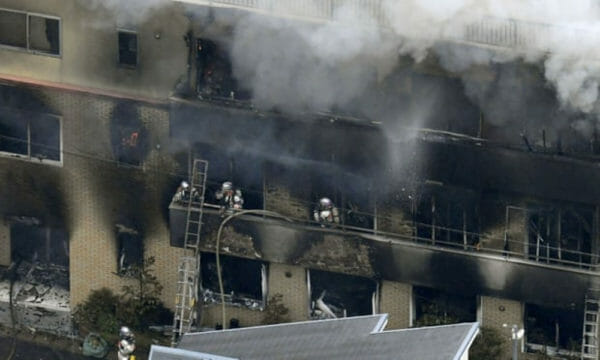
Fayetteville, AR – -(AmmoLand.com)- On Thursday (18 July 2019), an arsonist attacked Kyoto Animation (KyoAni) anime studio in Kyoto, Japan. The suspect is reported to have poured gasoline around the first floor of the three-floor studio before setting it alight, killing thirty-three and injuring thirty-five others at the time of this writing.
According to the police, the suspect claimed as he was being arrested that the studio had plagiarized his work, though law enforcement has not had time to investigate the suspect’s motives. KyoAni is noted as being a standout in the industry for treating employees well and is known among fans of anime for the K-On! series, among others.
Japan consistently shows up in discussions of guns and homicide rates among developed nations. Always cited by gun control advocates as an ideal, a society that makes private legal possession of firearms all but impossible, and it is true to say that their rate of intentional homicides has been consistently lower than that of the United States for over a century, especially in recent years. The Japanese rate of gun crimes is also far below ours.
There are a variety of reasons—cultural and historical—for this that are beyond the scope of this article. My purpose here is to consider the specific category of mass homicides, a type of violence that is properly included under the general heading of terrorism if we do not insist on limiting the latter to violence committed for exclusively political effect. An attack on a workplace, whether for revenge or because the attacker is deranged, is terrifying, regardless of any political implications.
The Global Terrorism Index measures the “lives lost, injuries, property damage, and the psychological aftereffects” in calculating a score between zero and ten. Japan’s is about half ours. While gun crimes of any type are rare in Japan, stabbing attacks—including multiple fatalities are common. Despite the belief among gun control advocates that being stabbed is somehow safer than being shot—an attack with a truck on a shopping center, and the Aum Shinrikyo attacks with sarin gas are now joined by this arson attack, Each illustrating what we in the gun community have been saying for a long time: If someone has decided to kill a lot of people at once, the means available to him are many.
Fortunately, most people are not seeking to do this, and such mass killings are rare. If you don’t live in several countries in Africa or southern Asia, you are unlikely to be involved in a terrorist incident. And while mass shootings seize the headlines, they remain a small part of homicides, with or without firearms.
This is not to say that we should treat mass killings as if they do not matter. The fact that some people are willing to murder others is a lingering darkness in human nature, and killing people in groups is on the outer extreme of that territory. Addressing this requires greater work in mental health services, intelligent law enforcement that treats threats of violence and the commission of domestic violence seriously, and a dialing down of the notion that violence is a desirable route to fame or political fortune.
But what does not make sense is disarming the law-abiding as a response to terrorism.
About Greg Camp
Greg Camp has taught English composition and literature since 1998 and is the author of six books, including a western, The Willing Spirit, and Each One, Teach One, with Ranjit Singh on gun politics in America. His books can be found on Amazon. He tweets @gregcampnc.
